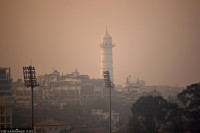Climate & Environment
Met office forecasts heavy rainfall in some places until Saturday
Red alerts for 43 districts and yellow for 34 districts including those in the Valley.
Arjun Poudel
The Department of Hydrology and Meteorology has forecast extremely heavy rainfall in some places of the country until Saturday morning.
According to a special bulletin issued by the department, most parts of the country will witness light to moderate rainfall and some places could see extremely heavy rainfall from Wednesday night to Saturday morning.
Some places of Koshi, Madhesh, Gandaki, and Lumbini provinces could witness rain with thunder and lightning in that period. Extremely heavy rainfall is likely in some places of the four provinces.
Red alerts have been issued in 43 districts of Koshi, Madhesh, Bagmati, Gandaki and Lumbini provinces.
Yellow alerts have been issued in the remaining 34 districts including all three districts of Valley—Kathmandu, Lalitpur and Bhaktapur.
The department has cautioned the public about risks of land erosion, debris flow and inundation in urban areas and in the Tarai.
The department warns that water level will increase in big and small rivers and streams.
“Everyday life, agriculture, health, tourism, road and air transport could also be affected,” the bulletin stated.
There will also be rainfall in Sudurpaschim and Karnali provinces, according to Saroj Pudasaini, a meteorologist.
Several districts across the country witnessed landslides, flooding, and inundation due to the rainfall that continued since Friday last week.
According to the National Disaster Risk Reduction and Management Authority (NDRRMA), which is under the Ministry of Home Affairs, at least 38 people—17 males and 21 females—have died in landslides since the start of the monsoon. At least 50 people were injured, and 419 families were affected. The authority recorded 144 landslides and 57 floods in the past week.
As many as 15 people, six males and nine females, have been killed, and four others were missing in the flood incidents. The authority said that 708 families have been affected by flood incidents.
Since the start of the monsoon on June 10, as many as 74 people have succumbed to various disaster-related incidents, including lightning strikes.
The Department of Hydrology and Meteorology said that the Dodhara weather station of Kanchanpur recorded 624 mm of rainfall, the Hanuman Nagar weather station recorded 573.6 mm of rainfall, and the Sundarpur weather station recorded 555.8 mm of rainfall on Sunday and Monday, the heaviest rainfall recorded in 24 hours in the past 77 years.
The monsoon season in Nepal generally begins on June 13 and ends on September 23. This year, the monsoon entered Nepal from the southwest on June 10, three days ahead of the usual onset date. Last year, it started on June 14, a day later than the normal onset day.
A normal monsoon, supported by the timely arrival of rain, translates into favourable agricultural production, mainly of paddy, and is intricately linked with the country’s overall economic growth.
The monsoon season, which delivers around 80 percent of the country’s total annual rainfall, generally lasts for 105 days. But, in recent years, it has been taking more time to withdraw.
The Met office has forecast above-normal rains and above-average maximum and minimum temperatures this monsoon, which could unleash extreme weather events, such as flooding, inundation and landslides.
The department’s climate section has issued a weather forecast for four months, from June to September. It said most parts of the country are likely to experience above-average minimum and maximum temperatures and rainfall due to weakened El Niño conditions and the development of La Niña conditions.
El Niño refers to climatic patterns in which ocean surface temperatures warm unusually. La Niña is the opposite, in which the ocean surface cools off.
Nepal is one of the world’s most vulnerable countries to the climate crisis and has witnessed multiple extreme weather events over the past decade and a half.
Evidence suggests that maximum temperatures in Nepal are rising faster, at 0.056 degrees Celsius a year, compared to the global average rise of 0.03 degrees Celsius a year.
Experts say extreme weather events—excessive rainfall in a short period, continuous rains for several days after the monsoon, dry spells, droughts, below-average precipitation, and above-normal winter temperatures—have become more frequent in Nepal.
The National Disaster Risk Reduction and Management Authority estimates that 1.81 million people and 412,000 households will be affected by monsoon this year. Of them, 83,000 households will be directly impacted, and 18,000 families will require rescue due to monsoon-related disasters.




 5.4°C Kathmandu
5.4°C Kathmandu








%20(1).jpg&w=300&height=200)

